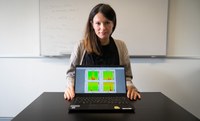Helping people with speech disorders
It is now easier to diagnose which motor speech disorder a patient has, like for example hypokinetic dysarthria from Parkinson’s disease or mixed dysarthria from Wilson’s disease among others. A clinical tool named “MonPaGe-2.0.s protocol” was already in place to check if someone is suffering from a speech disorder. Whether such a tool could be used to differentially diagnose different disorders was unknown.
Ina Kodrasi and her collaborators contributed to a recent breakthrough showing that the MonPaGe-2.0.s protocol allows to differentiate which motor speech disorder a person is suffering from among six different possible diagnoses. This achievement was made possible thanks to Kodrasi’s expertise in machine learning applied to speech. A new model was trained using recordings from 60 speakers suffering from mild to moderate motor speech disorders. Recordings were then represented by seven important acoustic features exploited to determine what type of disorder is present in the recording. These features reflect intelligibility, articulation, voice, speech rate, maximum phonation time (i.e., the time an individual can sustain a sung tone), prosody (i.e., the rhythmic and intonational aspect of language), and diadochokinetic rate (i.e., how quickly you can accurately repeat a series of rapid, alternating sounds).
“These seven features have well known links to motor speech disorders, but we found that only four were really relevant to discriminate among the different disorders. In the future we aim to design additional features to further improve our machine learning model,” Kodrasi explains. The end goal of this collaboration is to make the diagnosis more accurate through a tool that clinicians can use. “Working within such an interdisciplinary consortium has been really interesting. Participants come from their own field, with their own point of view, and their own vocabulary. It wasn’t easy to understand each other at the beginning but it really became easier afterwards,” Kodrasi concludes. This work is done in collaboration with phoneticians and neuroscientists from the Sorbonne-Nouvelle University in Paris and the University of Geneva.
A new project regarding pathological speech enhancement
Until today, speech enhancement techniques in digital communication generally target neurotypical speakers, i.e., speakers that do not suffer from speech disorders. But a new project, called “PAuSE: Pathological Speech Enhancement” granted by the Swiss National Science Foundation will allow Kodrasi to grow her research group by hiring two PhD students to work on developing model-based and deep learning-based speech enhancement approaches that yield an advantageous performance also for pathological speakers.
More information
- Signal Processing for Communication group
- “Differentiation of Motor Speech Disorders through the Seven Deviance Scores from MonPaGe-2.0.s”, Cécile Fougeron, Ina Kodrasi and Marina Laganaro in Brain Sciences, 29 October 2022
- “PAuSE: Pathological Speech Enhancement” research project
